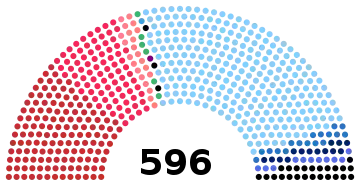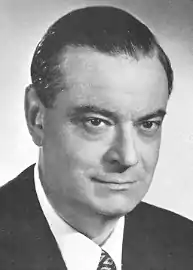1958 Italian general election
The 1958 Italian general election was held in Italy on 25 May 1958.[1] The number of MPs to be elected was calculated upon the population's size for the last time.
| |||||||||||||||||||||||||||||||||||||||||||||||||||||||||||||||||||||||||||||||||||||
All 596 seats in the Chamber of Deputies 299 seats needed for a majority All 246 elective seats in the Senate 127 seats needed for a majority[lower-alpha 1] | |||||||||||||||||||||||||||||||||||||||||||||||||||||||||||||||||||||||||||||||||||||
|---|---|---|---|---|---|---|---|---|---|---|---|---|---|---|---|---|---|---|---|---|---|---|---|---|---|---|---|---|---|---|---|---|---|---|---|---|---|---|---|---|---|---|---|---|---|---|---|---|---|---|---|---|---|---|---|---|---|---|---|---|---|---|---|---|---|---|---|---|---|---|---|---|---|---|---|---|---|---|---|---|---|---|---|---|---|
| Registered | 32,434,852 (C) · 29,183,501 (S) | ||||||||||||||||||||||||||||||||||||||||||||||||||||||||||||||||||||||||||||||||||||
| Turnout | 30,434,681 (C) · 93.8% ( 27,425,843 (S) · 93.9% ( | ||||||||||||||||||||||||||||||||||||||||||||||||||||||||||||||||||||||||||||||||||||
| |||||||||||||||||||||||||||||||||||||||||||||||||||||||||||||||||||||||||||||||||||||


| |||||||||||||||||||||||||||||||||||||||||||||||||||||||||||||||||||||||||||||||||||||
| |||||||||||||||||||||||||||||||||||||||||||||||||||||||||||||||||||||||||||||||||||||
Electoral system
Minor changes were made to the electoral law in 1958, creating a system which would remain unchanged until its abrogation in 1993.
The pure party-list proportional representation was definitely adopted for the Chamber of Deputies. Italian provinces were united in 32 constituencies, each electing a group of candidates. At constituency level, seats were divided between open lists using the largest remainder method with Imperiali quota. Remaining votes and seats were transferred at national level, where they were divided using the Hare quota, and automatically distributed to best losers into the local lists.
For the Senate, 237 single-seat constituencies were established, even if the assembly had 9 more members. The candidates needed a landslide victory of two thirds of votes to be elected: only 5 hoping senators reached this goal. All remained votes and seats were grouped in party lists and regional constituencies, where a D'Hondt method was used: inside the lists, candidates with the best percentages were elected.
Historical background
After De Gasperi's retirement in 1953, Fanfani emerged as the anticipated successor, a role confirmed by his appointment as party secretary from 1954 to 1959.[2] He reorganized and rejuvenated the national party organization of the Christian Democrats after the dependence on the church and the government which had typified the De Gasperi period.[3]
Fanfani's activist and sometimes authoritarian style, as well as his reputation as an economic reformer, ensured that the moderates within the DC, who opposed the state's intrusion into the country's economic life, regarded him with distrust. His indefatigable energy and his passion for efficiency carried him far in politics, but he was rarely able to exploit fully the opportunities that he created. One politician once remarked: "Fanfani has colleagues, associates, acquaintances and subordinates. But I have never heard much about his friends."[4]
Parties and leaders
Results
The election gave similar results of five years before and, consequently, the same problems of political instability of the centrist formula. Christian Democracy was polarized by a fraction which liked more leftist politics, and another one which urged for a rightist route. Party's secretary Amintore Fanfani was in the first field, and called for a dialogue with the Italian Socialist Party, which had frozen its relationships with the Italian Communist Party after the Hungarian Revolution. Fanfani led a year-term government, but the reaction of the conservative fraction gave the power to Antonio Segni, followed by Fernando Tambroni who received a decisive vote of confidence by the neo-fascist Italian Social Movement. The MSI had been banned by any type of political power since its birth under the theory of the Constitutional Arch, which stated that any government or opposition party which had voted the Italian Constitution, had to refuse any relationship with fascist and monarchist forces, seen as anti-constitutional groups. Strikes and revolts causing some casualties erupted through the country, and Tambroni had to resign. Fanfani returned to the premiership, this time with an openly centre-left programme supported by the socialist abstention. The government created the middle school for workers' sons, and the ENEL after the electric energy nationalisation.
Chamber of Deputies
 | |||||
|---|---|---|---|---|---|
| Party | Votes | % | Seats | +/– | |
| Christian Democracy | 12,520,207 | 42.35 | 273 | +10 | |
| Italian Communist Party | 6,704,454 | 22.68 | 140 | −3 | |
| Italian Socialist Party | 4,206,726 | 14.23 | 84 | +9 | |
| Italian Social Movement | 1,407,718 | 4.76 | 24 | −5 | |
| Italian Democratic Socialist Party | 1,345,447 | 4.55 | 22 | +3 | |
| Italian Liberal Party | 1,047,081 | 3.54 | 17 | +4 | |
| People's Monarchist Party | 776,919 | 2.63 | 14 | New | |
| Monarchist National Party | 659,997 | 2.23 | 11 | −29 | |
| Italian Republican Party–Radical Party | 405,782 | 1.37 | 6 | +1 | |
| Community Movement | 173,227 | 0.59 | 1 | New | |
| South Tyrolean People's Party | 135,491 | 0.46 | 3 | 0 | |
| Movement for Piedmontese Regional Autonomy | 70,589 | 0.24 | 0 | New | |
| Valdostan Union | 30,596 | 0.10 | 1 | New | |
| Catholic National Resurrection Party | 15,929 | 0.05 | 0 | New | |
| Autonomous Federation of Italian Social Democrats | 9,332 | 0.03 | 0 | New | |
| National Labour Party | 7,183 | 0.02 | 0 | New | |
| Autonomy Piemont-Villarboito Movement | 6,955 | 0.02 | 0 | New | |
| Union of Trieste | 6,661 | 0.02 | 0 | New | |
| Independence Front | 6,305 | 0.02 | 0 | New | |
| Pro-Pensioners Movement | 4,987 | 0.02 | 0 | New | |
| Italian Soldiers' United Front | 4,172 | 0.01 | 0 | New | |
| European Democratic Concentration | 4,133 | 0.01 | 0 | New | |
| Independent Divorce Movement | 3,955 | 0.01 | 0 | New | |
| Sicilian Social Party | 3,136 | 0.01 | 0 | New | |
| Italian National Movement | 1,499 | 0.01 | 0 | 0 | |
| Action-Renewal Movement | 752 | 0.00 | 0 | New | |
| Italian Social Economic Movement | 571 | 0.00 | 0 | New | |
| Italian Party of Borrowers and War Invalids | 465 | 0.00 | 0 | New | |
| Total | 29,560,269 | 100.00 | 596 | +6 | |
| Valid votes | 29,560,269 | 97.13 | |||
| Invalid/blank votes | 874,412 | 2.87 | |||
| Total votes | 30,434,681 | 100.00 | |||
| Registered voters/turnout | 32,434,852 | 93.83 | |||
| Source: Ministry of the Interior | |||||
Results by constituency
| Constituency | Total seats |
Seats won | |||||||||
|---|---|---|---|---|---|---|---|---|---|---|---|
| DC | PCI | PSI | MSI | PSDI | PLI | PMP | PNM | PRI–PR | Others | ||
| Turin | 26 | 11 | 6 | 4 | 2 | 1 | 1 | 1 | |||
| Cuneo | 14 | 8 | 2 | 2 | 1 | 1 | |||||
| Genoa | 21 | 9 | 5 | 4 | 1 | 1 | 1 | ||||
| Milan | 39 | 15 | 9 | 7 | 1 | 3 | 2 | 1 | 1 | ||
| Como | 14 | 8 | 2 | 3 | 1 | ||||||
| Brescia | 19 | 12 | 2 | 3 | 1 | 1 | |||||
| Mantua | 10 | 5 | 3 | 2 | |||||||
| Trentino | 10 | 5 | 1 | 1 | 3 | ||||||
| Verona | 29 | 18 | 4 | 4 | 1 | 1 | 1 | ||||
| Venice | 16 | 9 | 3 | 3 | 1 | ||||||
| Udine | 14 | 8 | 2 | 2 | 1 | 1 | |||||
| Bologna | 27 | 7 | 10 | 4 | 1 | 2 | 1 | 2 | |||
| Parma | 19 | 7 | 7 | 3 | 1 | 1 | |||||
| Florence | 13 | 5 | 6 | 2 | |||||||
| Pisa | 15 | 6 | 5 | 3 | 1 | ||||||
| Siena | 9 | 3 | 4 | 2 | |||||||
| Ancona | 19 | 8 | 5 | 3 | 1 | 1 | 1 | ||||
| Perugia | 13 | 5 | 4 | 3 | 1 | ||||||
| Rome | 39 | 16 | 9 | 5 | 4 | 1 | 1 | 1 | 1 | 1 | |
| L'Aquila | 17 | 8 | 4 | 2 | 1 | 1 | 1 | ||||
| Campobasso | 6 | 4 | 1 | 1 | |||||||
| Naples | 34 | 14 | 8 | 3 | 1 | 1 | 1 | 6 | |||
| Benevento | 21 | 10 | 4 | 2 | 1 | 1 | 1 | 1 | 1 | ||
| Bari | 22 | 10 | 7 | 3 | 1 | 1 | |||||
| Lecce | 18 | 9 | 4 | 2 | 2 | 1 | |||||
| Potenza | 8 | 4 | 2 | 1 | 1 | ||||||
| Catanzaro | 26 | 13 | 6 | 3 | 1 | 1 | 1 | 1 | |||
| Catania | 29 | 13 | 6 | 3 | 2 | 1 | 2 | 1 | 1 | ||
| Palermo | 29 | 13 | 6 | 3 | 2 | 1 | 1 | 1 | 1 | 1 | |
| Cagliari | 15 | 8 | 3 | 2 | 1 | 1 | |||||
| Aosta Valley | 1 | 1 | |||||||||
| Trieste | 4 | 2 | 1 | 1 | |||||||
| Total | 596 | 273 | 140 | 84 | 24 | 22 | 17 | 14 | 11 | 6 | 4 |
Senate of the Republic
 | |||||
|---|---|---|---|---|---|
| Party | Votes | % | Seats | +/– | |
| Christian Democracy | 10,780,954 | 41.23 | 123 | +10 | |
| Italian Communist Party | 5,700,952 | 21.80 | 59 | +8 | |
| Italian Socialist Party | 3,682,945 | 14.08 | 35 | +9 | |
| Italian Democratic Socialist Party | 1,164,280 | 4.45 | 5 | +1 | |
| Italian Social Movement | 1,150,051 | 4.40 | 8 | −1 | |
| Italian Liberal Party | 1,012,610 | 3.87 | 4 | +1 | |
| People's Monarchist Party | 774,242 | 2.96 | 5 | New | |
| Monarchist National Party | 565,045 | 2.16 | 2 | −14 | |
| Italian Republican Party – Radical Party | 363,462 | 1.39 | 0 | 0 | |
| MSI – PNM | 291,359 | 1.11 | 0 | 0 | |
| PCI – PSI | 185,557 | 0.71 | 2 | 0 | |
| Community Movement | 142,897 | 0.55 | 0 | New | |
| South Tyrolean People's Party | 120,068 | 0.46 | 2 | 0 | |
| Movement for Piedmontese Regional Autonomy | 61,088 | 0.23 | 0 | New | |
| PSI – PSDI | 43,191 | 0.17 | 0 | 0 | |
| Left-wing independents | 28,141 | 0.11 | 1 | +1 | |
| Sardinian Action Party | 25,923 | 0.10 | 0 | 0 | |
| Key | 12,686 | 0.05 | 0 | New | |
| Bruno Buitoni | 11,540 | 0.04 | 0 | New | |
| Three Peaks of Lavaredo | 9,928 | 0.04 | 0 | New | |
| Tota Sabina Civitas | 6,449 | 0.02 | 0 | New | |
| National Monarchist Party | 4,729 | 0.02 | 0 | New | |
| National Labour Party | 3,588 | 0.01 | 0 | New | |
| Socialist Unification | 3,110 | 0.01 | 0 | New | |
| Four-Leaf Clover | 2,818 | 0.01 | 0 | New | |
| Rural Movement | 2,389 | 0.01 | 0 | New | |
| Total | 26,150,002 | 100.00 | 246 | +9 | |
| Valid votes | 26,150,002 | 95.35 | |||
| Invalid/blank votes | 1,275,841 | 4.65 | |||
| Total votes | 27,425,843 | 100.00 | |||
| Registered voters/turnout | 29,183,501 | 93.98 | |||
| Source: Ministry of the Interior | |||||
Results by constituency
| Constituency | Total seats |
Seats won | ||||||||
|---|---|---|---|---|---|---|---|---|---|---|
| DC | PCI | PSI | MSI | PSDI | PMP | PLI | PNM | Others | ||
| Piedmont | 18 | 9 | 4 | 3 | 1 | 1 | ||||
| Aosta Valley | 1 | 1 | ||||||||
| Lombardy | 33 | 16 | 6 | 7 | 1 | 2 | 1 | |||
| Trentino-Alto Adige | 6 | 4 | 2 | |||||||
| Veneto | 20 | 13 | 3 | 3 | 1 | |||||
| Friuli-Venezia Giulia | 6 | 4 | 1 | 1 | ||||||
| Liguria | 8 | 4 | 2 | 2 | ||||||
| Emilia-Romagna | 18 | 6 | 8 | 3 | 1 | |||||
| Tuscany | 16 | 7 | 6 | 3 | ||||||
| Umbria | 6 | 2 | 2 | 2 | ||||||
| Marche | 7 | 4 | 2 | 1 | ||||||
| Lazio | 17 | 8 | 4 | 2 | 2 | 1 | ||||
| Abruzzo and Molise | 8 | 5 | 2 | 1 | ||||||
| Campania | 22 | 10 | 5 | 2 | 1 | 3 | 1 | |||
| Apulia | 16 | 8 | 4 | 2 | 1 | 1 | ||||
| Basilicata | 6 | 4 | 2 | |||||||
| Calabria | 10 | 5 | 3 | 1 | 1 | |||||
| Sicily | 22 | 10 | 5 | 2 | 2 | 1 | 1 | 1 | ||
| Sardinia | 6 | 4 | 2 | |||||||
| Total | 246 | 123 | 59 | 35 | 8 | 5 | 5 | 4 | 2 | 5 |
References
- Nohlen, Dieter; Stöver, Philip (2010). Elections in Europe: A Data Handbook (hardcover ed.). Nomos. p. 1048. ISBN 978-3-8329-5609-7.
- "Italy: Young Initiative". Time. 12 July 1954. Archived from the original on 13 August 2009. Retrieved 2 February 2022.
- "Out for the Big Win". Time. 26 May 1958. Archived from the original on 31 January 2011. Retrieved 2 February 2022.
- "Italy: Moving to the Left". Time. 14 July 1958. Retrieved 2 February 2022.
- taking into account the Senators for life, which accounted for 6 seats at the time the election took place
- Togliatti also served as secretary of the Communist Party of Italy from 1926 to 1934 and from 1938 to 1943.
- Nenni also served as secretary from 1933 to 1939 and from 1943 to 1945.
- Saragat also served as secretary from 1949 to 1952 and from 1952 to 1954.

.jpg.webp)

.jpg.webp)
.jpg.webp)
